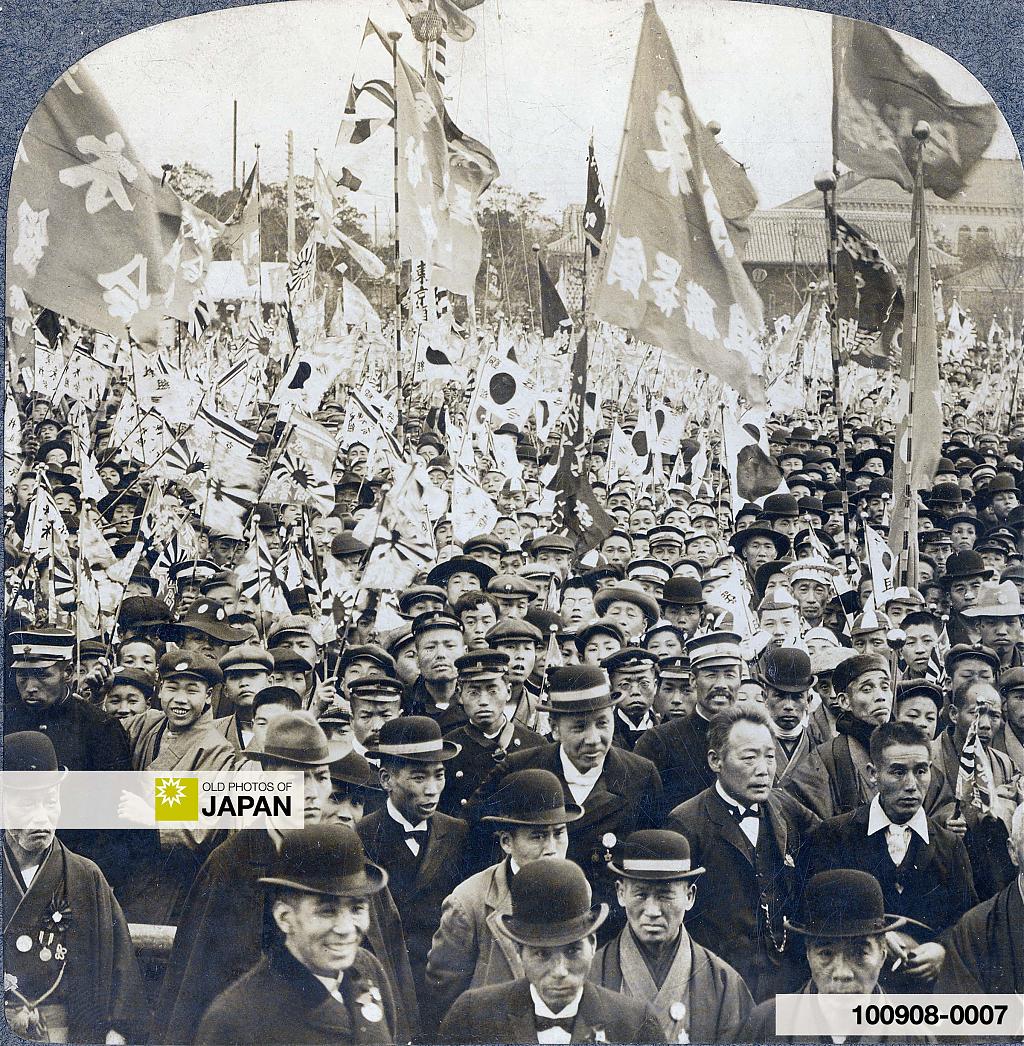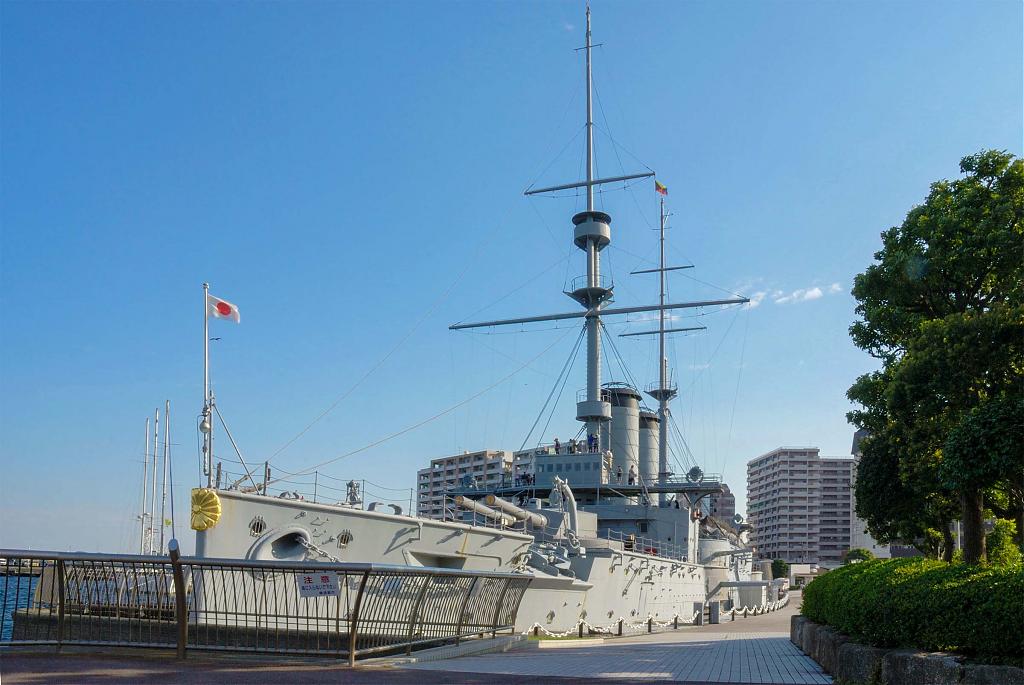I love it when I discover the story behind a photo. Especially when that story is as amazing as this one. This photo doesn’t really appear special or important. Just a Japanese man wearing glasses posing next to a photo of a ship. But when I dug a little deeper, I discovered something extraordinary.
There are important clues in the photo itself. Look more closely at the photo and you will notice that the newspaper on the desk is the Japan Times. The ship in the photo is the Imperial Japanese Navy battleship Mikasa (三笠). This was the flagship of Admiral Heihachiro Togo (東郷 平八郎, 1848–1934) during the Russo-Japanese War of 1904–1905 (Meiji 37–38).
Even more intriguing is that the photo is actually signed by Togo. I own a poster signed by Togo and you can clearly recognize his signature on the far left.

According to some text pasted to the back of the photo, the man with the glasses was Japan Times editor Kimpei Shiba (芝均平, 1903–1996), photographed in 1929 (Showa 4).123
As it turns out, Shiba was instrumental in saving the Mikasa from destruction in 1923 (Taisho 12).
Following the Washington Naval Treaty (九カ国条約) of 1922, the ship was scheduled to be scrapped. Thanks to Shiba’s negotiations, the signatories of the treaty agreed that the Mikasa could be preserved as a memorial ship.
As a token of thanks, the Japanese Ministry of the Navy and Admiral Togo presented him with this photo signed by the admiral.4 The command that Togo gave at the start of the Battle of Tsushima is written on the photo:
The Empire’s fate depends on the result of this battle, let every man do his utmost duty.

So, who was Kimpei Shiba?
Shiba was born in Hawaii, but graduated from the Canadian Academy in Kobe (神戸カナディアン・アカデミー).5 In 1924 (Taisho 13), he began working for The Japan Times.6
From 1929 (Showa 4) through 1941, Shiba was the Chicago Tribune’s Tokyo correspondent, after which he became editor of The Japan Times.7 In 1954 (Showa 29), Shiba founded the Asahi Evening News, the English-language edition of the Asahi Shimbun.8 He retired from the company in 1986 (Showa 61).9 He wrote several books, such as I cover Japan, in which Shiba explored Japan’s decade following the end of WWII.
Online, I could find no information about Shiba’s role in saving the Mikasa. There is not even a Wikipedia page for the man. He seems to have been mostly forgotten.
But the ship he saved is still well-known. The Mikasa is now a museum ship in Yokosuka.
Just a photo of a Japanese man wearing glasses posing next to a photo of a ship…

Notes
1 In text pasted to the back of the photo, Shiba’s name is written as Kimpei Sheba, the spelling he used for the Chicago Tribune.
2 Webcat Plus. 芝 均平. Retrieved on 2019-12-14.
3 Chicago Tribune. Kimpei Shiba, Ex-Tribune Writer. Retrieved on 2019-12-14.
4 Text pasted to the back of the photograph.
5 Chicago Tribune. Kimpei Shiba, Ex-Tribune Writer. Retrieved on 2019-12-14.
6 ibid.
7 ibid.
8 Asahi Shimbun. Corporate Overview. Retrieved on 2019-12-14.
9 Chicago Tribune. Kimpei Shiba, Ex-Tribune Writer. Retrieved on 2019-12-14.
Published
Updated
Reader Supported
Old Photos of Japan aims to be your personal museum for Japan's visual heritage and to bring the experiences of everyday life in old Japan to you.
To enhance our understanding of Japanese culture and society I track down, acquire, archive, and research images of everyday life, and give them context.
I share what I have found for free on this site, without ads or selling your data.
Your support helps me to continue doing so, and ensures that this exceptional visual heritage will not be lost and forgotten.
Thank you,
Kjeld Duits
Reference for Citations
Duits, Kjeld (). 1920s: Saving Battleship Mikasa, OLD PHOTOS of JAPAN. Retrieved on December 12, 2025 (GMT) from https://www.oldphotosjapan.com/photos/852/saving-battleship-mikasa




Rohan Gillett
More amazing pictures! And another equally amazing story! The Mikasa was a great ship which I visited many years ago. I think it is now open again to the public after having closed due to coronavirus. I agree, we all owe a huge debt to Shiba for saving the ship as it is of huge historical importance (and a pity so many more can’t be saved along with it too). He must have led an incredibly interesting life.
#000681 ·
Kjeld Duits (Author)
@Rohan Gillett: Thank you. Although I live relatively close by, I still haven't visited!
#000683 ·
JAURENA
Bonjour,
Magnifique !
Un travail long et minutieux.
Un site conçu avec TXP.
勇ましい。
#000694 ·